By Christine Pentecost–
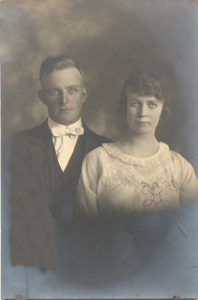
Chances are you have family photos like this stored away that are just begging to come to life again.
Digitally restoring old and damaged photos and bringing them back to life has been a very rewarding and challenging hobby for me over the past 15 years. I have restored photos from the late 1800s that were mounted on cardboard, to Polaroids from the 70s, and to photos ravaged by Hurricane Katrina’s flooding.
The heartwarming tears of joy I have witnessed upon returning a restored photo to the owner has always made the hard work worthwhile.
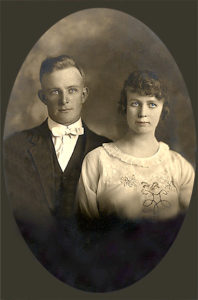
Here’s one of my grandparents’ wedding in 1920 that I scanned and restored. Now the question was what kind of paper to print it on to keep the flavor of the times.
And, sometimes, old photos don’t need to be restored, but copies need to be made. However, taking an old photo, particularly from the early 20th century and having it printed at your local drug store photo kiosk is not going to provide a very comparable result.
Most of today’s photo services offer paper on either glossy or luster, which is quite different from the types of paper used centuries or even decades ago. A photo taken around 1910, printed on a thick matte finish paper stock will not look nearly as authentic if printed on modern day glossy paper!
When working with my photo restoration/reprinting clients, I always provide them with the most authentic prints that I can, based on the time era of when the photo was taken. And, because Red River Paper has such a large selection of photo papers available, it’s been easy to replicate these old photos.
I make sure to keep Red River paper sampler packs on hand, both the Inkjet Photo & Fine Art Sampler, and Specialty Media Sampler. I will then take each photo that I have and peruse the sampler papers, until I determine which paper best meets my photographic needs.
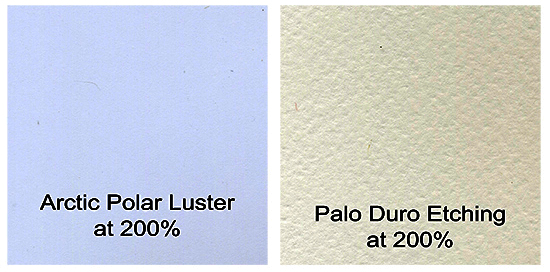
Papers have different color values (cold tone and warm tone) as well as different surface textures. Usually a warm tone paper like Palo Duro Etching that has some surface texture is best for printing old photos.
The history of photography is quite amazing, beginning back in the early 1800s with Daguerreotype prints, and progressing to Polaroid prints introduced in 1963. There have been a great many different photographic processes over the years, and when reprinting these photos on a paper that is most similar to the time in which the original was made helps maintain the authenticity of your reprinted image.
For example, in the early 1900’s, photos were often printed on post cards, also called “Real Photo Post Cards.” They have a matte finish and are printed on thick paper, and, for those, I like to use 88lb. Polar Matte Magna. The thickness and matte finish are extremely similar to the original post cards.
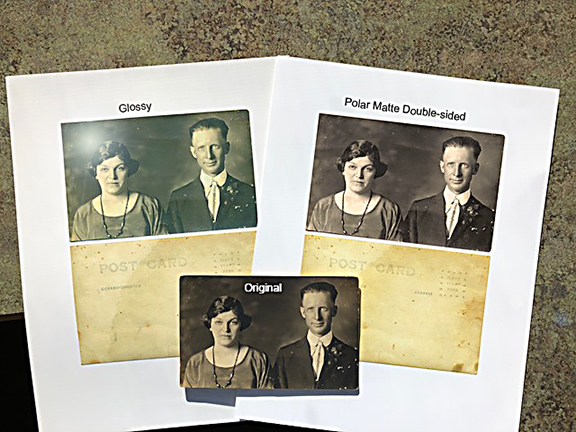
A comparison of glossy vs. matte on the same image. Glossy picks up more reflections while matte is more subdued and goes well with most old pictures, especially portraits. These are Postcard pictures taken early in the 20th Century.
Should you want to print the back side of the post card along with the photo, you may want to try 60lb. Polar Matte Double-sided paper. While not quite as thick as the original post card, it is a heavy-weight paper that gives the same appearance as the Polar Matte Magna, but is printable on both sides.
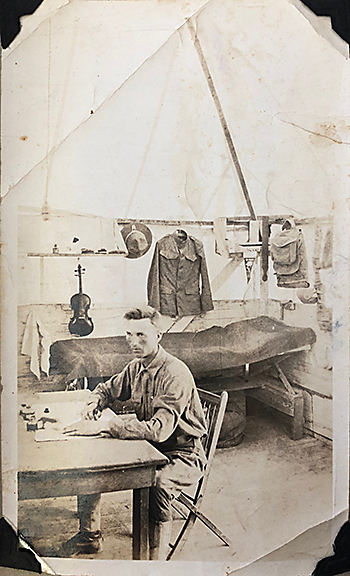
This is an old Army photo of my great uncle Roy. Many military pictures were printed on glossy paper so it’s best to use that surface when replicating them.
I have a photo of my great uncle Roy, taken in World War II, printed on a very thin, glossy type paper. Zeppelin Semi-Gloss was a perfect match for this photo, and once I had restored the photo, it was almost identical to the original!
Yet, a photo of my grand parents from 1963 was printed on a very thick high gloss paper. The 96lb. Pecos Gloss was a perfect match to reproduce my grandparents’ photo.
Making reproductions is not limited to just photographs. I recently restored a baptismal and wedding document that was on a heavy textured paper, and literally falling apart. Aside from wanting the document restored, the family requested that it be printed on paper authentic to the original. I once again found the perfect match, with Palo Duro Etching paper.
Another family had a very old photo from the early 1940s that was hand tinted and on a heavy watercolor type of paper. They had the original, but someone had given them reprints on modern era glossy paper. I was able to scan the original photo and do reprints on Palo Duro Etching paper, which provided them with prints almost identical to the original.
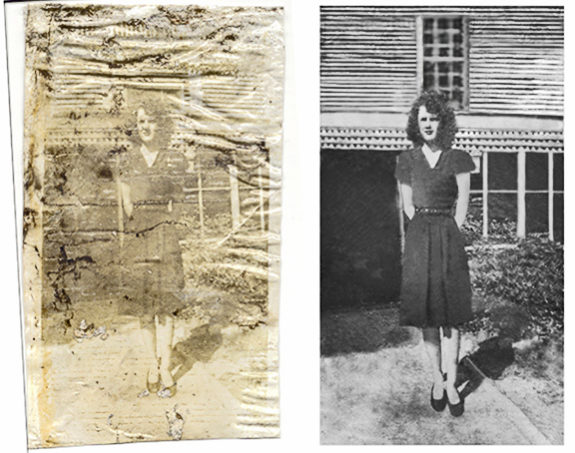
Restoring old photos can be very rewarding and in some cases, like this one that went through a fire, very time consuming. The efforts are well worth it, though, when you see the gratitude expressed by the person who thought all their photo memories were lost.
If you enjoy restoring photos, a great place to volunteer is Operation Photo Rescue. They began after Hurricane Katrina and are a non-profit organization that restores photos damaged by natural disasters. They have since collected photos from all over the United States, and have volunteers from all over the world, You can visit their website and sign up to be a volunteer.
ABOUT THE AUTHOR: Christine Pentecost is a Red River Pro who lives in Montana. One of her specialties is restoring and copying antique and damaged images. For more about her or to contact her click here.
EDITOR’S COMMENT: It is extremely difficult, and in most cases impossible, to show different paper surfaces on a computer monitor as all surfaces appear to be the same. An inexpensive paper sampler is highly recommended as an aid to making final choices.
RESOURCES:
Inkjet Photo & Fine Art Sampler and Specialty Media Sampler
88lb. Polar Matte Magna Card Stock
60lb. Polar Matte Double-sided
45lb Zeppelin Semi-Gloss (To be discontinued, limited supplies available)
96lb. Pecos River Gloss Heavy Card Stock
NOTE: Some of the above heavy papers are also available in lighter weights.
Operation Photo Rescue: www.OperationPhotoRescue.org. You can also make a donation to this non-profit organization.
Related Posts and Information
Last updated: February 26, 2018




